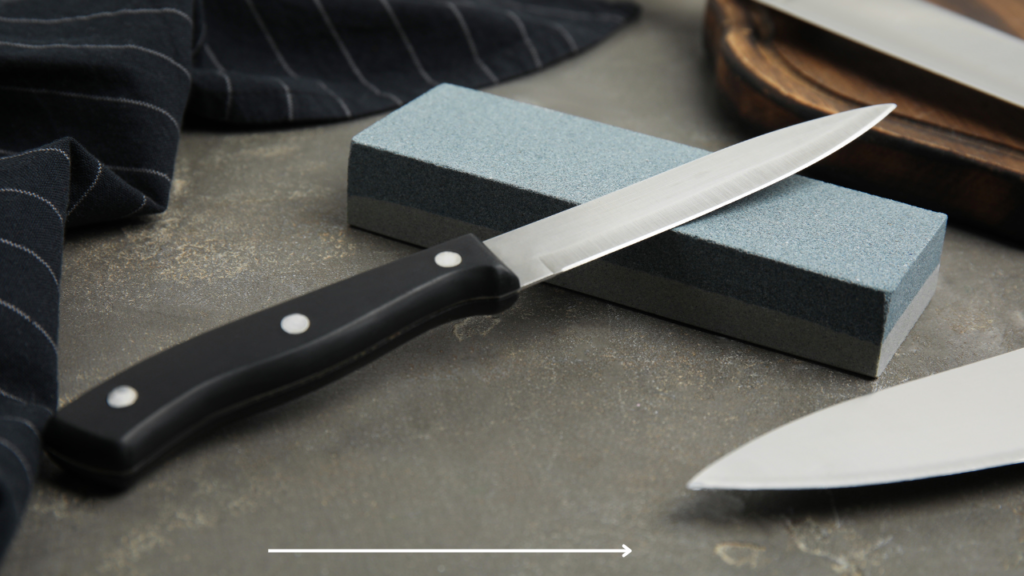A sharp kitchen knife isn’t just a luxury—it’s a game-changer. Whether you’re slicing veggies or carving a roast, a dull blade slows you down and makes cooking feel like a chore. That’s where a good whetstone comes in. But with so many options, figuring out what gritstone for kitchen knives can get confusing. Should you start with a coarse grit or jump straight to a polishing stone? In this guide, I’ll break it all down—grit levels, the best whetstone for your needs, and pro tips to keep your knives razor-sharp.
Understanding Whetstone Grit Levels
What Is Whetstone Grit?
Think of whetstone grit like sandpaper for knives. The lower the number, the rougher it is. Rough stones fix dull or damaged edges quickly. Higher numbers mean a finer surface, which makes your blade super sharp.
Ever tried slicing a tomato with a dull knife? It smashes instead of slicing. A good whetstone fixes that. But you need the right grit for the job.
How the Grit Numbering System Works
Here’s a simple rule: Lower grit removes metal. Higher grit makes the edge smooth.
- Coarse (200–600 grit): Great for fixing dull or chipped knives.
- Medium (800–2000 grit): Best for regular sharpening.
- Fine (3000–8000 grit): Perfect for polishing and razor-sharp edges.
Do you need all three? Not always. A 1000/6000 combination whetstone works for most people. But if your knife is super dull, start with a coarse stone first.
What Grit Whetstone Should You Use for Kitchen Knives?
So, you’ve got a kitchen knife that’s seen better days. Maybe it struggles to slice through a ripe tomato, or it feels like you’re sawing through a bell pepper. That’s your cue—it’s time to sharpen that blade. But what gritstone should you use? Let’s break it down.
Choosing the Right Grit Based on Knife Condition
Extremely Dull or Damaged Blades (200–600 Grit) If your knife is so dull that it crushes food instead of cutting it, or if you’ve got nicks and chips in the blade, you need a coarse grit stone. These stones (200–600 grit) act like a reset button for your knife, grinding away damage and restoring the basic edge. Think of it like sanding rough wood before applying a finish.
Regular Maintenance & Sharpening (1000–2000 Grit) If your knife isn’t damaged but has lost its sharpness, a medium-grit stone (1000–2000) is your best bet. This range brings back a keen edge without being too aggressive. For most home cooks, a 1000-grit whetstone is the go-to for regular sharpening. It’s the sweet spot—removes enough metal to sharpen effectively but isn’t too abrasive.
Polishing & Refining Edges (3000–8000 Grit) Once your knife is sharp, you can take it to the next level with a fine-grit whetstone (3000–8000). These stones don’t just sharpen; they refine. The higher the grit, the smoother the edge. A 5000+ grit stone gives you that buttery-smooth, razor-sharp finish—great for precision cutting, like slicing fish or delicate herbs.
Best Grit Combination for Kitchen Knives
Best for Beginners: 1000/6000 Combination Stone If you’re just starting, a dual-sided stone with 1000 grit on one side and 6000 on the other is a fantastic choice. The 1000 grit keeps your knife sharp, while the 6000 grit polishes it to perfection. It’s a two-in-one solution that covers most sharpening needs without overwhelming you.
For Professional Chefs: Multiple Grit Levels If you’re serious about knife sharpening, having a set of stones in different grit levels is ideal. Many pros start with 400 or 600 grit for dull blades, move to 1000 grit for sharpening, and finish with 5000+ for a razor-sharp edge. It’s a bit more effort, but the results are unbeatable.

Best Whetstone Brands for Kitchen Knives
Alright, so you know what gritstone you need—now let’s talk brands. Not all whetstones are created equal, and picking the right one can make sharpening a breeze instead of a frustrating chore. Whether you’re a beginner or a pro chef, here are some top-notch options to consider.
Best Overall: Shapton, Naniwa, King
If you want a reliable, high-quality whetstone that delivers consistent results, these brands are top-tier.
- Shapton: Known for their ceramic-based stones, Shapton whetstones don’t require soaking—just splash and go! They cut fast and last a long time, making them a favorite among professionals.
- Naniwa: If you’re looking for silky-smooth sharpening, Naniwa’s Super Stones are unbeatable. They’re slightly softer, which helps achieve a refined, polished edge.
- King: The go-to brand for many sharpening beginners. Affordable, effective, and widely available, King Stones are a solid choice if you’re just getting started.
Budget-Friendly: Sharp Pebble, BearMoo
You don’t have to spend a fortune to keep your knives sharp. These budget-friendly options work well without breaking the bank.
- Sharp Pebble: A favorite on Amazon, this brand offers double-sided stones (like 1000/6000 grit) that cover both sharpening and polishing. Perfect for home cooks who want good results at a reasonable price.
- BearMoo: Another affordable option, BearMoo stones are great for beginners and casual users. They work well but require proper soaking before use to prevent cracking.
Premium Options: Chosera, Suehiro
If you’re serious about knife sharpening and want the best of the best, these brands offer premium-quality whetstones.
- Chosera (by Naniwa): These are professional-grade stones that provide exceptional sharpening speed and precision. They’re pricey but worth every penny if you’re looking for top-tier performance.
- Suehiro: High-end stones that deliver a buttery smooth finish. If you’re into Japanese knives and want that razor-sharp edge, Suehiro stones are an excellent investment.
Which One Should You Choose?
- For beginners: A 1000/6000 grit combination stone from King or Sharp Pebble is an excellent starting point.
- For serious home cooks: Naniwa or Shapton stones will give you pro-level sharpness with minimal effort.
- For professionals: Chosera or Suehiro stones offer unmatched precision and performance.
Common Mistakes to Avoid When Using a Whetstone
Sharpening your kitchen knives with a whetstone isn’t rocket science, but it does take a little finesse. A few simple mistakes can turn the process from effective to frustrating. Here’s what to watch out for so you don’t end up dulling your blade instead of sharpening it.
Using the Wrong Grit for Your Knife’s Condition
Ever tried sanding a rough piece of wood with ultra-fine sandpaper? It doesn’t work. The same goes for sharpening knives. If your blade is chipped or dull beyond recognition, starting with a high-grit stone (like 6000) is a waste of time. You need a coarse stone (200–600 grit) to reset the edge first.
Not Maintaining a Consistent Sharpening Angle
This is where most people go wrong. If your angle wobbles all over the place, you’re not sharpening—you’re just scratching up your knife. A consistent angle (usually 15–20 degrees for kitchen knives) is key to getting a sharp, even edge.
Applying Too Much or Too Little Pressure
Some people press down on their knife like they’re trying to crush the whetstone. Others barely apply any pressure at all, expecting magic to happen. Both are mistakes. Too much force can wear down your knife unevenly, while too little means you won’t remove enough metal to create a sharp edge.
Forgetting to Flatten the Whetstone Periodically
Over time, your whetstone will develop grooves from repeated use. A bumpy surface makes it harder to get a consistent edge, which means you’re sharpening inefficiently.

FAQs
Can I use one whetstone for all my knives?
Technically, yes—but it’s not ideal. If you only have one, a 1000/6000 combo stone is your best bet. It sharpens well and polishes decently. But if you’re working with seriously dull blades or high-end knives, using multiple grits (coarse, medium, and fine) will give you the best results.
How often should I sharpen my kitchen knives?
It depends on how often you use them! If you’re cooking daily, a quick sharpening session every 3–4 weeks keeps them in top shape. For occasional cooks, every 2–3 months works fine. But here’s a trick: If your knife struggles to slice through a ripe tomato cleanly, it’s time to sharpen.
Do I need to soak my whetstone before use?
It depends on the type. Traditional whetstones (like King and Naniwa) need a 10–15 minute soak before sharpening. But splash-and-go stones (like Shapton) just need a little water on the surface. If you’re unsure, check the manufacturer’s instructions—because soaking a non-soak stone can ruin it!
What’s the difference between a whetstone and a honing rod?
A whetstone sharpens your knife by grinding down metal to create a new edge. A honing rod doesn’t sharpen—it just straightens the existing edge, keeping it aligned between sharpening sessions. Think of the honing rod as a quick tune-up, while the whetstone is the full service.
How do I clean and store a whetstone properly?
After sharpening, rinse your whetstone with warm water (no soap!), gently scrub off the metal residue with a brush, and let it air dry completely. Store it in a dry place—moisture can cause mold or cracks. And if you notice uneven wear, flatten it with a lapping stone to keep it in top condition.
Conclusion
Choosing the right grit for your kitchen knives is more than just a technical decision—it’s about enhancing your cooking experience. A sharp knife not only makes prep work faster, but it also ensures safety and precision. Whether you’re chopping herbs or slicing a roast, the right edge makes a world of difference. By selecting the appropriate grit, you can extend the life of your knives and make sure they stay in top shape.
Investing in a good whetstone is a small step that pays off big over time. It’s not just about sharpening; it’s about making your knives feel like new again, every time you use them. And trust me, once you experience the difference between a dull blade and a perfectly honed one, you’ll never look back.
So, pick the grit that suits your needs—whether you’re just maintaining your knives or restoring a damaged edge. Remember, a 1000/6000 combination stone is a great starting point, while more advanced users can explore multiple grit options for a professional finish. No matter what, a well-maintained knife makes cooking easier and more enjoyable, and that’s the ultimate goal. Happy sharpening!

I’m a writer and culinary expert with over 10 years of experience in the kitchen. As a graduate of the Institute of Culinary Education and a passionate home chef, I created KitchenBreez.com to share my knowledge of kitchen techniques, cooking tips, and the best kitchen gadgets. Whether you’re a seasoned cook or just starting, my goal is to help you make your time in the kitchen more efficient and enjoyable.
